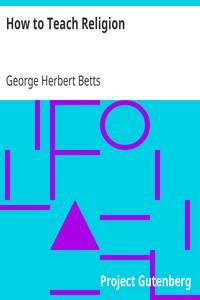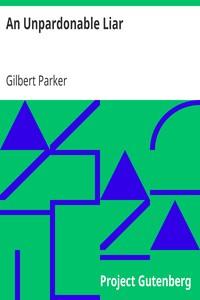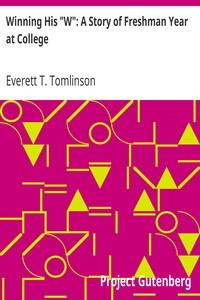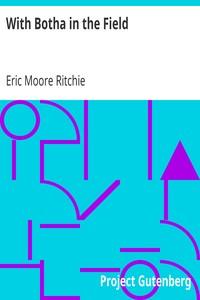|
|
Read this ebook for free! No credit card needed, absolutely nothing to pay.Words: 67299 in 19 pages
This is an ebook sharing website. You can read the uploaded ebooks for free here. No credit cards needed, nothing to pay. If you want to own a digital copy of the ebook, or want to read offline with your favorite ebook-reader, then you can choose to buy and download the ebook.

: How to Teach Religion Principles and Methods by Betts George Herbert - Religious education; Religion Study and teaching Christianity@FreeBooksTue 06 Jun, 2023 Importance of the teacher--Three types of teachers--The personal factor in teaching religion--Developing the power of personality--The cultivatable factors in personality--A scale for determining personality--The teacher's mastery of subject-matter--Methods of growth--Fields of mastery demanded--Service and rewards--Problems and questions. Not all religious knowledge of equal value--What determines value of knowledge--Kind of knowledge needed by child--Developing the child's idea of God--Harm from wrong concepts of God--Giving the child the right concept of religion--The qualities by which religion should be defined to the child--The child's knowledge of the Bible; of the church; of religious forms of expression--Problems and questions. The meaning of religious attitudes--These attitudes lie at the basis of both motives and character--Importance of the pupil's attitudes toward the church school and class--Enjoyment of the lesson hour and the growth of loyalty--The sense of mastery necessary to mental and spiritual growth--The grounding of a continuous interest in the Bible and religion--Growth in spiritual warmth and responsiveness--The cultivation of ideals--The training of fine appreciations--Worthy loyalties and devotions--Clearness of God-consciousness--Questions and problems. Religious instruction must carry across to life and conduct--Hence necessity of finding practical outlet in expression for feelings, ideals, emotions and attitudes resulting from instruction--The setting up of certain religious habits--Expression in connection with the life of the church--Expression in the home life--Expression in the community and public school life--Expression in worship and the devotional life--Problems for discussion. The Bible the great source-book of religious material--Yet much material other than biblical required--Principles for the selection of material from the Bible--Biblical material for early childhood; for later childhood; for adolescence--Story material and its sources--Materials from nature--Materials from history and biography--Picture material for religious teaching--Religious music for children--Questions and problems. Four different types of organization--Organization applied to the curriculum as a whole, to individual lessons--Haphazard organization--Logical organization--Chronological organization--Psychological organization--Three types of curriculum organization: Uniform lessons, Graded lessons, text books of religion--Organizing daily lesson material--Typical lesson plans--Problems for discussion. Teaching that sticks--Attention the key--Types of appeal to attention--The control of interest--Interest and action--Variety and change as related to interest--Social contagion of interest--The prevention of distractions--The control of conduct--Danger points in instruction--Establishing and maintaining standards--Questions and problems. The several types of lessons for religious instruction--The informational lesson--The use of the inductive lesson--The deductive lesson in religion--The application of drill to religious teaching--The lesson in appreciation--Conducting the review lesson--How to make the lesson assignment--Questions and problems. Methods of procedure for the lesson hour--The use of the topical method--Place and dangers of the lecture method--Securing participation from the class--The question method--Principles of good questioning--The treatment of answers--The story method--Guiding principles in story teaching--The teaching method of Jesus--Jesus the embodiment of all scientific pedagogy--Questions and problems. EDITOR'S INTRODUCTION The teacher of religion needs to be very sure of himself at one point. He ought to be able to answer affirmatively the question, "Have I the prophetic impulse in my teaching?" Sooner or later, practical difficulties will "come not singly but by battalions," and the spirit needs to be fortified against discouragement. When driven back to the second or third line defense it is important that such a line really exists; the consciousness of being the spokesman for God makes the teacher invulnerable and unconquerable. This volume by Dr. Betts offers the earnest teacher of religion an exceptional opportunity to make more effective his ideal of instruction. The treatment applies the best of modern educational science to the problems of the church school, without, however, for a moment, forgetting that a vital religious experience is the final goal of all our teaching. Free books android app tbrJar TBR JAR Read Free books online gutenberg More posts by @FreeBooks
: Plum Pudding: Of Divers Ingredients Discreetly Blended & Seasoned by Morley Christopher - Essays Bibliomania@FreeBooksTue 06 Jun, 2023
|
Terms of Use Stock Market News! © gutenberg.org.in2025 All Rights reserved.






